This Post May Contain Affiliate Links. Please Read Our Disclosure Policy.
Learn how to cook beets easily and perfectly, whether you boil them, steam them, roast them, or microwave them! These vibrant root vegetables are a delicious way to add a little color to your table, and they boast an impressive amount of nutrients, too.
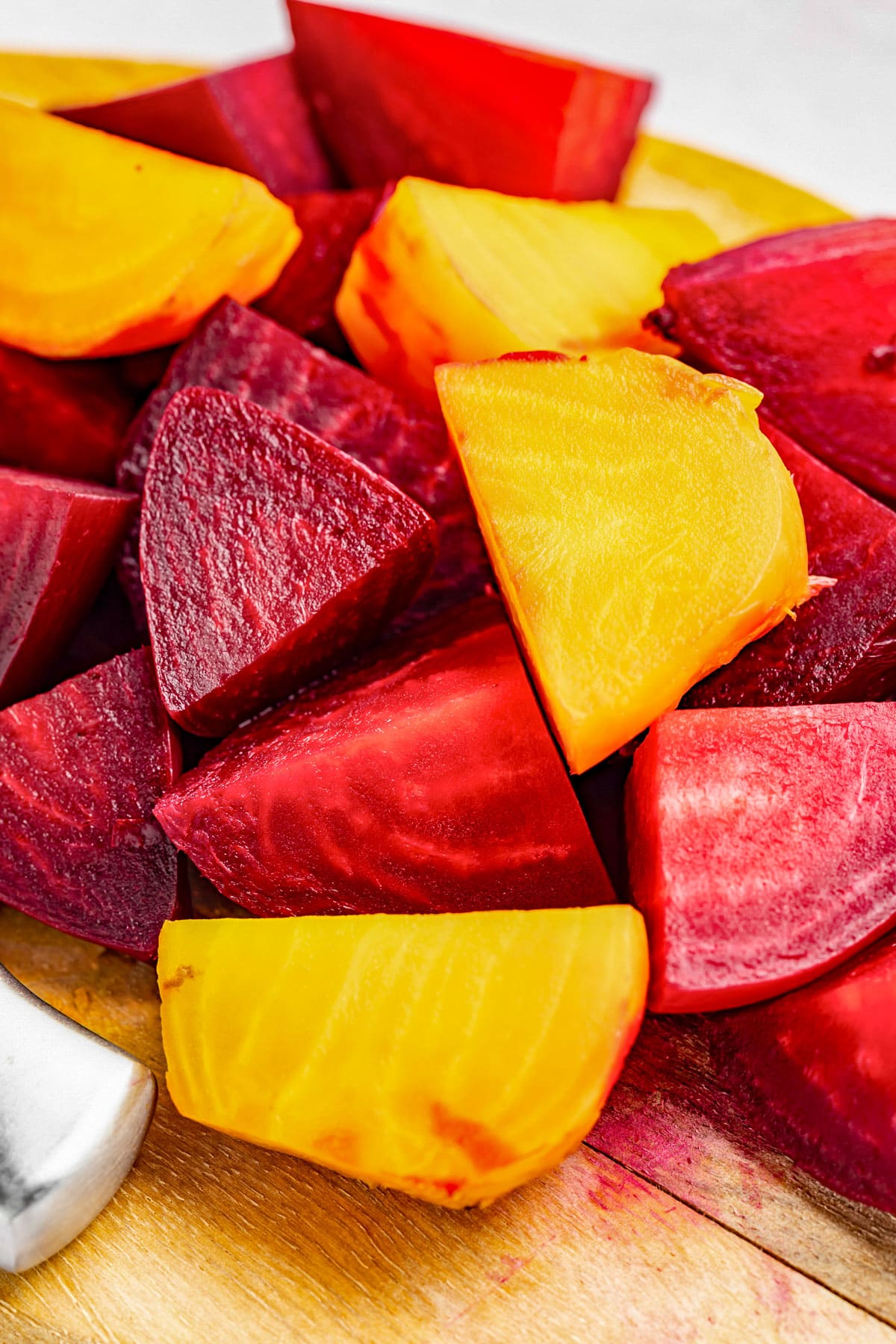
🤤 What Makes Beets So Great
Before we get into the “how to cook beets” part of the post, can we just take a second to talk about how great beets are? I feel like they’re generally unappreciated (or at least under-appreciated) for the most part, when there’s actually a lot to love about them!
- Beets contain an impressive number of important vitamins and minerals that your body needs. A 3.5-ounce serving of beets is low calorie, super low fat, rich in fiber, decently low carb, and contains roughly 20% of your daily value of folate, 14% of your daily value of manganese, 7% of potassium, and 4% each of vitamin C, vitamin B6, and iron. They’re also a good source of copper, which is important for energy production.
- Some studies have shown that beets can lower your blood pressure, and it’s no secret that high blood pressure can lead to a host of issues. Of course, they’re not a miracle food. If high blood pressure is something you struggle with, please consult with a medical professional!
- The health benefits don’t stop there. There are also studies that indicate beets can reduce inflammation, promote brain function and memory support, aid in digestion, improve oxygen use, and increase energy levels and endurance.
🥗 Ways to Enjoy Beets
Beets (or maybe you know them as beetroots) are surprisingly versatile. You can use them in a variety of ways!
- Turn them into fresh beet juice
- Pickle them for pickled beet tacos
- Grate them or thinly slice them and add them to a salad
- Make them into a creamy dip or hummus
- Roast them, boil them, steam them, or microwave them and enjoy them as a side for almost any dish
- Blend them into a smoothie
- Slice them very thin, then bake or air fry them into beet chips

🛒 How to Choose Fresh Beets
Knowing how to cook beets is only half the battle. You also want to be sure you know how to spot the best beets at the grocery store or farmers’ market! They come in all shapes, sizes, and colors, but these general guidelines apply to all of them.
Be sure to look for…
- Beets with a deep color and bright green leaves. Avoid any beets with wilted leaves.
- Small beets rather than large ones. They should be firm and feel heavy for their size.
- Any blemishes, bruises, cuts, or holes on the skin of the beets. If you see any of those, put that beet back and try again.
- The taproot! Try to find beets that still have the taproot – that long, thin root at the bottom of the beet – still attached. If the taproot is super hairy, though, that usually means the beet is older and likely to be tough inside.
👩🏼🍳 Chef’s Tips
- Beets are typically available year round, but they’re at their best in the fall and winter.
- Once you get your beets home, cut off the leaves and stems so they don’t pull moisture out of the beets. You can discard them or use them in another recipe.
- Store the unwashed beets in a produce bag or sealable bag in the fridge, ideally in the vegetable drawer. They’ll keep 2-3 weeks that way! When you’re ready to cook the beats (and you’ve decided how to cook them!) give them a gentle scrub under running water to remove as much surface dirt as possible.
- Whether or not you peel the beets is up to you. In my opinion, it’s not entirely necessary, since cooking the beets makes the skin soft enough to eat. That being said, the skin can taste kind of bitter, so keep that in mind. If you want to remove the skins, peel the beets before you roast them – it’s just easier that way. For boiled beets, steamed beats, or microwaved beats, you can cook them first. The skin will come off easily if you just rub them with a paper towel after cooking them.
- Beets are beautifully vibrant. That beautiful color can be really messy, though. Consider wearing gloves while working with beets, especially if you’re using red ones. That juice can (and will) stain anything it touches – your skin, your clothes, possibly even your bowls and cutting board.
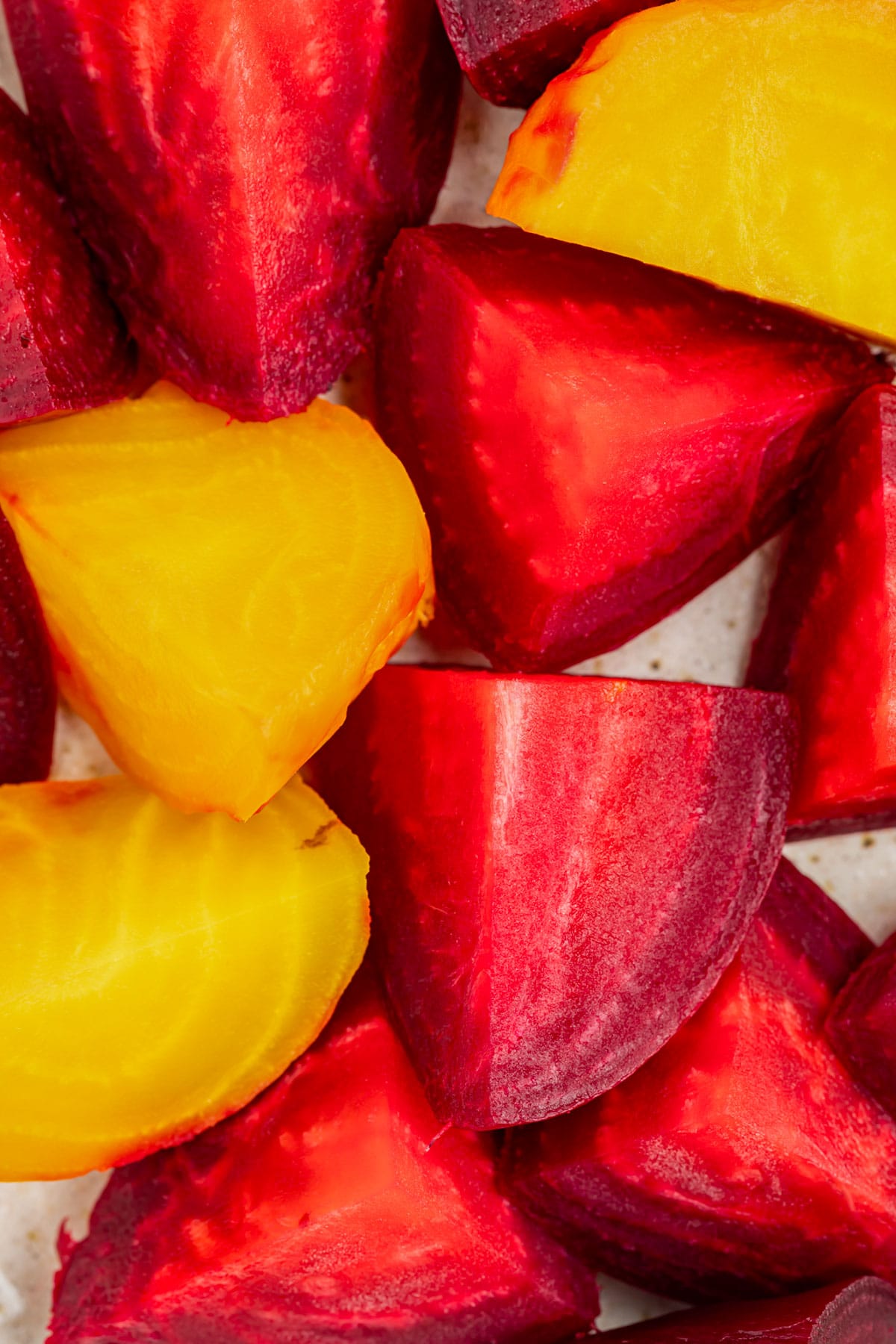
🧠 Other Must-Know How To’s and Cooking Basics
- How to Roast Garlic
- How Much Juice is in One Lime?
- All About Lemon Zest + 4 Ways to Zest a Lemon
- How to Cook Nopales (Cactus Paddles)
- Can You Freeze Cabbage?
- How to Cut Watermelon
- The Easiest Way to Dice an Onion
- How To Boil Corn on the Cob
- Three Ways to Freeze Zucchini
- How to Cook Turkey Bacon in the Oven
- Orange Zest – How to Make It and Ways to Use It
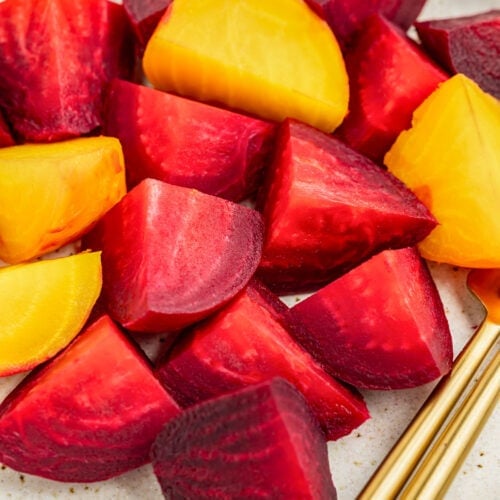
How to Cook Beets 4 Ways
Equipment
- cold running water
- vegetable brush
- Cutting board
- Sharp chef's knife
- Large, heavy-bottomed pot with lid; for boiled or steamed beets
- Large wooden spoon for boiled beets
- Fork or paring knife, to check doneness
- Slotted spoon for boiled beets
- Large bowl filled with cold water and ice
- Steamer basket for steamed beets
- Aluminum Foil for roasted beets
- large baking sheet for roasted beets
- medium mixing bowl for roasted beets
- Large microwave-safe bowl for microwaved beets
- Paper towels
Ingredients
For Boiled Beets
- 16 cups water
- 1 tablespoon salt
- 4 small beets approximately 3-4 ounces each
For Steamed Beets
- water enough to fill pot 2 inches
- 4 small beets approximately 3-4 ounces each
For Roasted Beets
- 4 small beets approximately 3-4 ounces each
- 1 tablespoon extra virgin olive oil
- salt to taste
For Microwaved Beets
- 4 small beets approximately 3-4 ounces each
- water enough to fill microwave-safe bowl halfway
Instructions
To Prepare Beets
- Wash beets under cold running water, using scrub brush to gently remove as much surface dirt as possible.
- Place washed beets on cutting board. Cut away leaves and stems, leaving approximately ½-inch to 1-inch of stem attached to beets. Discard trimmed leaves and stems, or save to use in other recipes.
For Boiled Beets
- Fill large pot with 16 cups water. Place pot on stovetop over medium-high heat and bring water to boil.
- Once water begins to boil, add 1 tablespoon salt and stir to incorporate. Allow water to return to rolling boil.
- When salted water begins to boil, add 4 small beets. Boil beets 20 minutes, then check doneness by piercing beets with fork or knife. Continue boiling as needed until fork or knife easily pierces beets with little to no resistance.
- When beets are tender, use slotted spoon to transfer beets from pot to ice bath. Let beets cool slightly, then gently rub beets with paper towels to remove skins.
- Serve or use boiled beets as desired.
For Steamed Beets
- Add 2 inches of water to large pot and place pot over medium-high heat. Fit steamer basket into pot, making sure bottom of basket does not touch water in pot.
- Heat water over medium-high heat until steam begins to rise through steamer basket. Once steaming, place 4 small beets in basket and cover with lid.
- Steam beets 25 minutes, then begin checking doneness with fork or knife. Continue steaming beets as needed until fork or knife easily pierces beets with little to no resistance.
- When beets are tender, carefully transfer beets from steamer basket to ice bath. Let beets cool slightly, then gently rub beets with paper towels to remove skins.
- Serve or use steamed beets as desired.
For Roasted Beets
- Preheat oven to 400° Fahrenheit. Tear 4 sheets of aluminum foil large enough to wrap each beet completely. Set foil sheets aside.
- Place 4 small beets in medium mixing bowl. Add 1 tablespoon extra virgin olive oil and salt to taste. Gently toss beets until completely covered in oil and salt.
- Once beets are well coated, wrap each beet in one sheet of aluminum foil, covering beets completely. Place foil-wrapped beets on baking sheet, leaving space between each foil pouch.
- Place baking sheet in preheated oven. Roast beets 30 minutes, then begin checking doneness. To check doneness, carefully unwrap one beet enough to pierce beet with fork or knife. If utensil does not pierce beet easily, rewrap beet and continue roasting until utensil pierces beet with little to no resistance.
- When beets are tender, carefully remove baking sheet from oven and set aside. Let beets cool slightly, then unwrap and discard foil.
- Serve or use roasted beets as desired.
For Microwaved Beets
- Prick 4 small beets with tines of fork, creating small vent holes over entire surface of each beet. Be careful not to force tines of fork too deeply into beets.
- Place beets in large, microwave-safe bowl. Add enough water to fill bowl halfway.
- Wet paper towels with water, then wring out excess water so paper towels are just damp. Cover mouth of bowl with single layer of damp paper towels.
- Place covered bowl in microwave. Microwave 4 minutes on full power, then check doneness with fork. If fork does not pierce beets easily, continue microwaving as needed until fork can pierce beets with little to no resistance.
- Once beets are tender, carefully remove bowl from microwave. Discard paper towels and transfer beets to ice bath. Let beets cool slightly, then gently rub beets with paper towels to remove skins.
- Serve or use microwaved beets as desired.
- Prep: Washing and scrubbing the beets is not optional!
- Beet Skins: Peeling the beets before or after cooking them is entirely optional. For roasted beets, peel them before roasting if you want them peeled. Beets cooked using the other 3 methods can be peeled after cooking.
- Cook Times: The cook times above apply to small beets specifically. Medium or large beets may need longer to cook, regardless of the method you choose.
- Leftovers: Refrigerate cooked beets in an airtight container up to 5 days.
- Instant Pot: To cook beets in the Instant Pot, check out this post!
Approximate Information for One Serving
Nutrition Disclaimers
Number of total servings shown is approximate. Actual number of servings will depend on your preferred portion sizes.
Nutritional values shown are general guidelines and reflect information for 1 serving using the ingredients listed, not including any optional ingredients. Actual macros may vary slightly depending on specific brands and types of ingredients used.
To determine the weight of one serving, prepare the recipe as instructed. Weigh the finished recipe, then divide the weight of the finished recipe (not including the weight of the container the food is in) by the desired number of servings. Result will be the weight of one serving.
Did You Make This Recipe?
Tag @40aprons on Instagram and be sure to leave a review on the blog post!


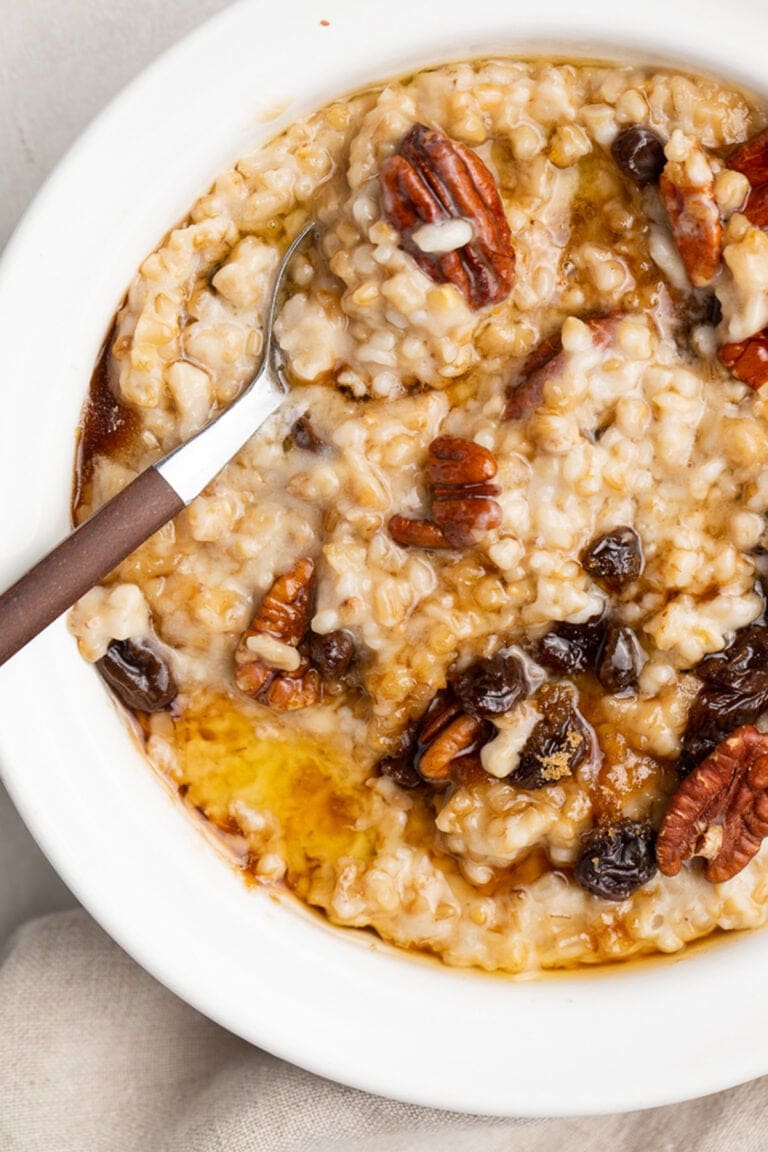
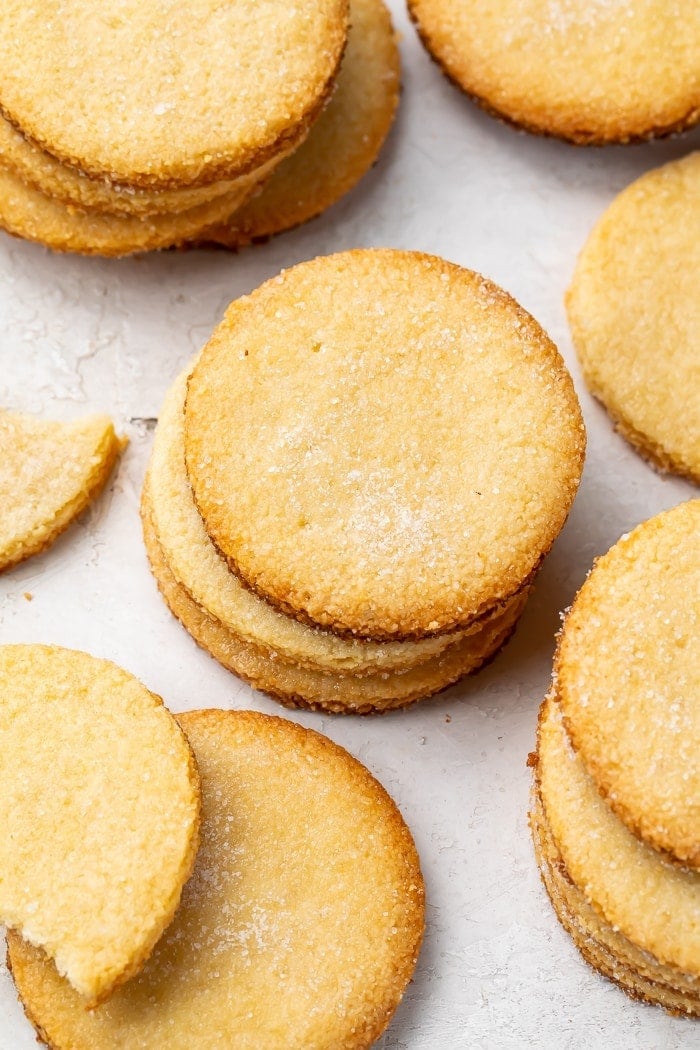
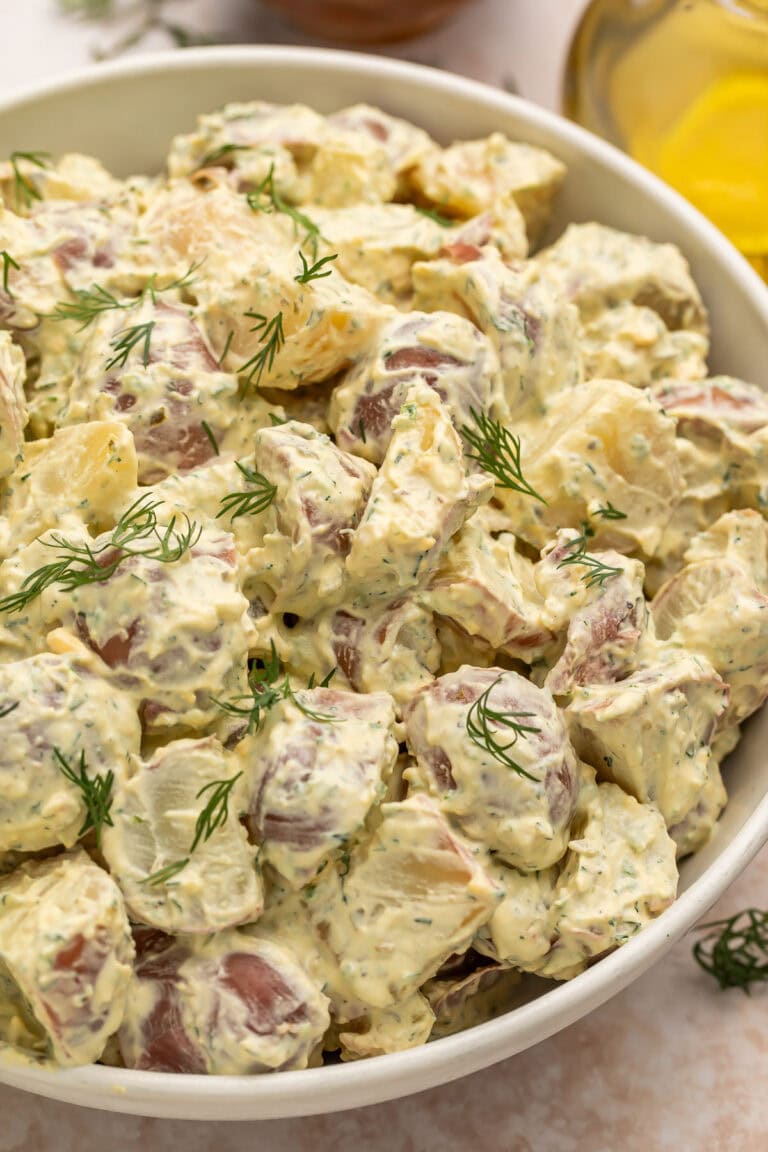
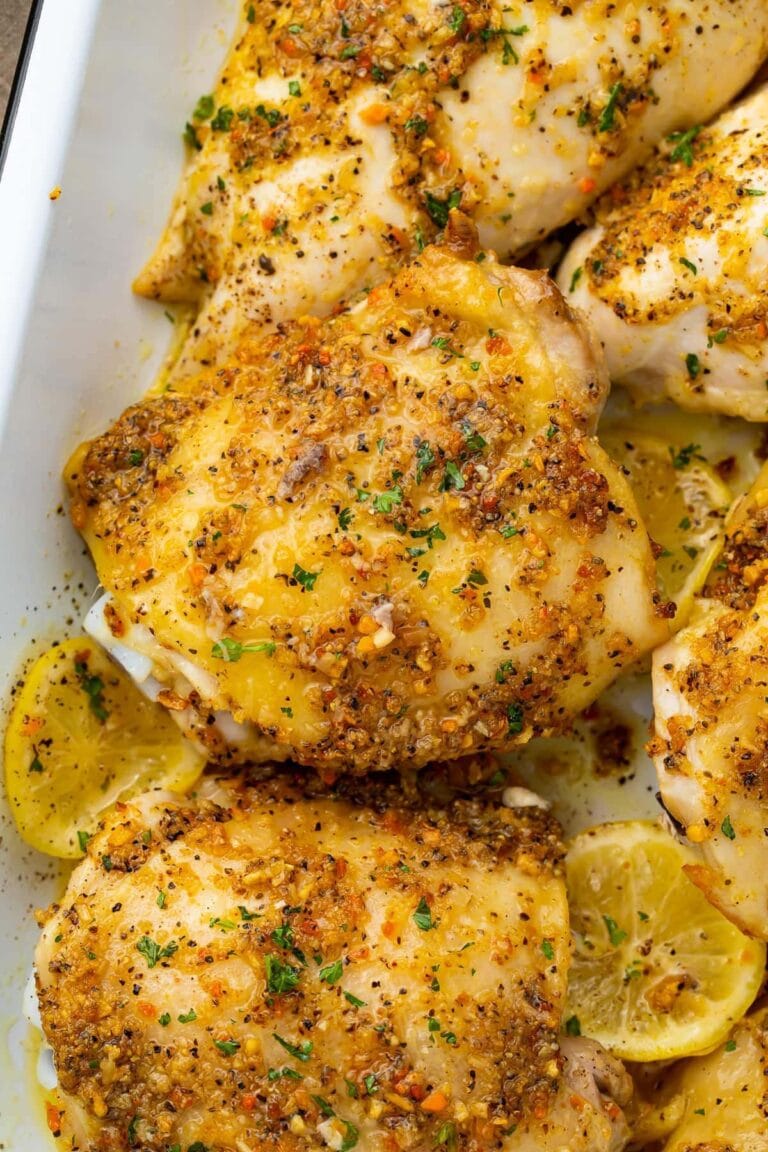










Never Miss A Meal!
New Recipes Straight To Your Inbox
A curated selection of our most recent recipes, delivered straight to your inbox once a week.
Thank you!
You have successfully joined our subscriber list.